

Personalize Internet Access and Manage Student Devices. CatchOn. Find What Works! About the Best Evidence Encylopedia. The Best Evidence Encyclopedia is a free web site created by the Johns Hopkins University School of Education's Center for Data-Driven Reform in Education (CDDRE) under funding from the Institute of Education Sciences, U.S.
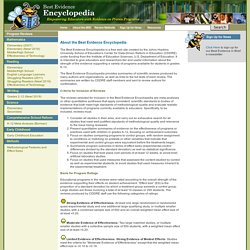
Department of Education. It is intended to give educators and researchers fair and useful information about the strength of the evidence supporting a variety of programs available for students in grades K-12. The Best Evidence Encyclopedia provides summaries of scientific reviews produced by many authors and organizations, as well as links to the full texts of each review. The summaries are written by CDDRE staff members and sent to review authors for confirmation.
Consider all studies in their area, and carry out an exhaustive search for all studies that meet well-justified standards of methodological quality and relevance to the issue being reviewed. N No Qualifying studies: No studies met inclusion standards. What is considered a large effect size? The Best Edtech for Students Is Backed by Research. Here’s What to Look For. In almost any school in the country today, you can find an app or program that claims to change education as we know it.
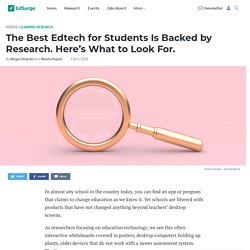
Yet schools are littered with products that have not changed anything beyond teachers’ desktop screens. As researchers focusing on education technology, we see this often: interactive whiteboards covered in posters, desktop computers holding up plants, older devices that do not work with a newer assessment system. The list goes on. Our work at the nonprofit Education Development Center’s Center for Children and Technology focuses on how education technology can be used to support learning. The truth is edtech products that foster more learning than would happen in analogue settings can be difficult to find. So naturally, one of the big questions we face is, how can we help ensure effective edtech happens more often?
Making Time for Research When it comes to making decisions about edtech purchases, teachers and administrators are pretty much on their own. K-12 Districts Wasting Millions by Not Using Purchased Software, New Analysis Finds. A new analysis of K-12 school district spending bolsters the notion that many ed-tech products and software purchased aren’t actually used or don’t have the intended impact.
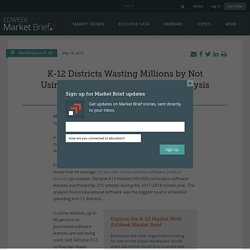
Ed-tech company Glimpse K12 studied $2 billion in school spending and found that on average, 67 percent of educational software product licenses go unused. Glimpse K12 tracked 200,000 curriculum software licenses purchased by 275 schools during the 2017-2018 school year. The analysis found educational software was the biggest source of wasted spending in K-12 districts. In some districts, up to 90 percent of purchased software licenses are not being used, said Glimpse K12 co-founder Adam Pearson. The analysis estimates that overall, the districts studied are losing about $2 million on these products throughout the school year. In the U.S. “This information is both insightful and alarming,” Pearson said. Glimpse K12 Unveils New Tool to Help Schools ‘Bundle’ and Save on Tech Purchases. The Edtech Buying Process Is Broken. ISTE Says Teachers Can Fix It.
At North Carolina’s Rowan-Salisbury Schools, a room in the central office showcases 3D printers, virtual reality headsets and a variety of iPad apps.
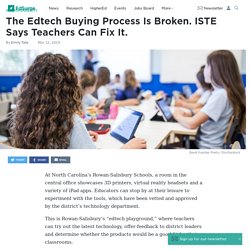
Educators can stop by at their leisure to experiment with the tools, which have been vetted and approved by the district’s technology department. This is Rowan-Salisbury’s “edtech playground,” where teachers can try out the latest technology, offer feedback to district leaders and determine whether the products would be a good fit for their classrooms. “In this space, the pressure of buying doesn’t exist,” says Andrew Smith, chief strategy officer for the district. “Instead, teachers get an open space that allows for thinking creatively and purposefully about the products. Does it meet students’ needs, or is it just really cool?” But according to the guide, examples like Rowan-Salisbury are few and far between. “Educators have so many options. Center for Improving Research Evidence (CIRE)
LearnPlatform. Edtech Advisor. School of Education at Johns Hopkins University-Center for Research and Reform. The Center for Research and Reform in Education (CRRE) was a research center within Johns Hopkins School of Education.
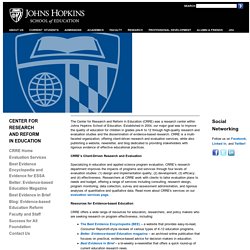
Established in 2004, our major goal was to improve the quality of education for children in grades pre-K to 12 through high-quality research and evaluation studies and the dissemination of evidence-based research. CRRE is a multi-faceted organization, offering client-driven research and evaluation services, while also publishing a website, newsletter, and blog dedicated to providing stakeholders with rigorous evidence of effective educational practices. CRRE’s Client-Driven Research and Evaluation Specializing in education and applied science program evaluation, CRRE’s research department improves the impacts of programs and services through four levels of evaluation studies: (1) design and implementation quality; (2) development; (3) efficacy; and (4) effectiveness. Digital Tools Are Everywhere-and Largely Unused-in Many Schools, New Analysis Shows. A new analysis breaks down how often schools and teachers are using the ed-tech tools bought by their districts.
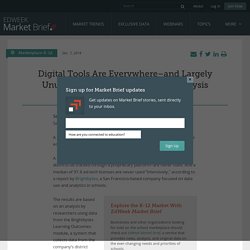
The findings are not pretty. A median of 30 percent of the ed-tech licenses purchased by K-12 districts–as tracked through a proprietary platform–are never used. And a median of 97.6 ed-tech licenses are never used “intensively,” according to a report by Brightbytes, a San Francisco-based company focused on data use and analytics in schools. The results are based on an analysis by researchers using data from the Brightbytes Learning Outcomes module, a system that collects data from the company’s district clients via each school system’s web proxy. Why Aren’t Schools Using the Apps They Pay For? With thousands of education apps available today, it can seem like students' success is in the palm of their hands.

But easy to forget is that technology is not in itself a solution. For it to work as intended, it must be paired with other critical elements: professional development for teachers, thoughtful implementation and consistent engagement. A new report that analyzes 1.48 million hours of technology usage by 390,000 students across 48 U.S. school districts underscores this point. School leaders expect students and teachers to be using their licensed apps all the time, says Ryan Baker, director of the University of Pennsylvania Center for Learning Analytics.
But in reality, most of the apps schools adopt are neglected. EdTechTeacher The Best Screencast Apps for Education - EdTechTeacher. TouchCast creates broadcast style videos that can literally be "touched.
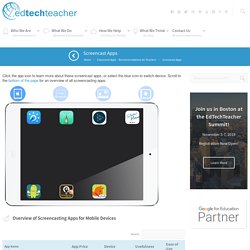
" Students can add interactive content such as web pages, Twitter feeds, and Google Maps to their original videos. Completed TouchCast videos can be shared as interactive videos to the TouchCast web site (login required) or to the camera as non-interactive videos (no login needed). Price: FreeEase-of-use: HardUsefulness: 5 out of 5. 6 Things Schools Need to Know About Interoperability. By Bill Fitzgerald In the world of education technology, it serves as a sort of Rorschach test: If you want to know how people feel about data use, privacy, security, and the role of tech in schools, ask them how they feel about interoperability.
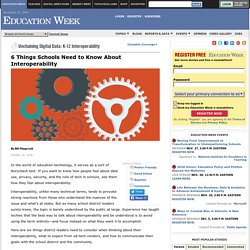
Interoperability, unlike many technical terms, tends to provoke strong reactions from those who understand the nuances of the issue and what’s at stake. But as many school district leaders surely know, the topic is barely understood by the public at large. JITEV14ResearchP021 053Yuan0700. Ed Tech Rapid Cycle Evaluation Coach. Evaluating Effective Use of Tech- ISTE Edtech Coaches Network. Learning Assembly – A network of learning innovators. Triple E Framework - Home.